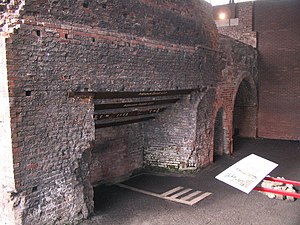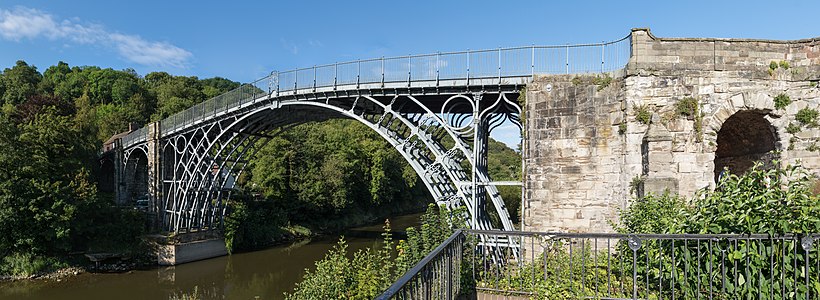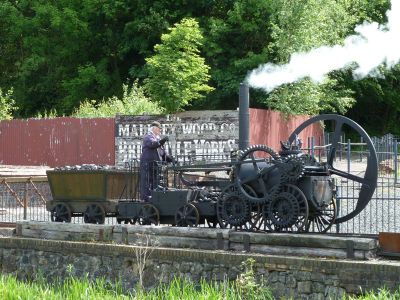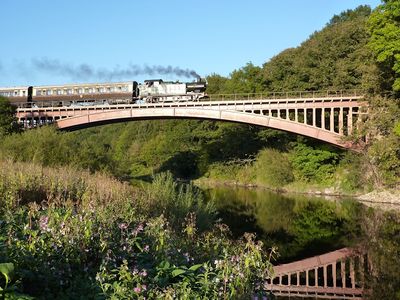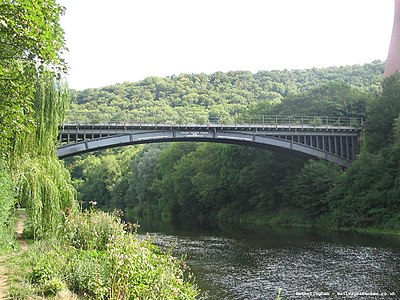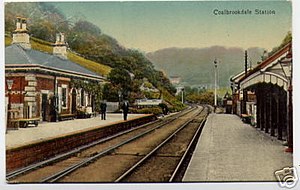Difference between revisions of "Coalbrookdale"
(create page for Coalbrookdale) |
(Add note on railtours) |
||
| (6 intermediate revisions by 2 users not shown) | |||
| Line 1: | Line 1: | ||
| − | Coalbrookdale is a village in the Ironbridge Gorge. It was the site of the furnace where Abraham Darby first smelted iron ore using "coking coal", a major factor in the start of the | + | [[File:The hearth of the Old Furnace at Coalbrookdale - geograph.org.uk - 571129.jpg|thumb|300px|right|The Darby furnace at Coalbrookdale]]'''Coalbrookdale''' is a village in the Ironbridge Gorge. It was the site of the furnace where Abraham Darby first smelted iron ore using "coking coal", a major factor in the start of the Industrial Revolution. The furnace is now preserved as part of the Ironbridge Gorge Museum.<ref name=IGT>Ironbridge Gorge Museum Trust</ref> |
| − | Coalbrookdale | + | ==The Coalbrookdale Company== |
| + | The Coalbrookdale Company was formed by Abraham Darby I in 1709 when he acquired the lease to the Coalbrookdale furnace. In 1768 his grandson Abraham Darby III began to produce the first cast-iron rails for railways, and in 1778 began casting parts for the world's first cast-iron bridge at Ironbridge which opened in 1780.<ref name=SH>[http://shropshirehistory.com/iron/coalbrookdale.htm Shropshire History]</ref> | ||
| − | The [[The Severn Valley Railway under GWR/BR ownership#Before construction: 1845-1858|first plans for the Severn Valley Railway]] proposed that the north end of the line should proceed towards Coalbrookdale. However following public meetings in October 1852, a route towards [[Shrewsbury]] was ultimately built instead.<ref>[[Bibliography#Books|Marshall (1989)]] pp. 21-22.</ref> | + | <gallery mode=packed heights=200px style="text-align:left"> |
| + | Cropped in of The Iron Bridge in 2014.jpg|The Iron Bridge | ||
| + | </gallery> | ||
| + | |||
| + | In 1802 the Company made the high pressure boiler and engine for one of Richard Trevithick’s early locomotives, a predecessor of [[Catch Me Who Can]].<ref name=SH/> It also built a number of its own standard gauge steam locomotives of which Number 5, built in 1865, is preserved as an exhibit in Enginuity, one of the Ironbridge Gorge Museums based at the Coalbrookdale site.<ref name=IGT/> | ||
| + | |||
| + | <gallery mode=packed heights=200px style="text-align:left"> | ||
| + | Trevithick_replica_20110531.jpg|Trevithick locomotive replica at Blists Hill Museum, Ironbridge in 2011. | ||
| + | Coalbrookdale_Company_5_20150110.jpg|Coalbrookdale Company No 5 at Enginuity in 2015 | ||
| + | </gallery> | ||
| + | |||
| + | The Coalbrookdale Company was responsible for the manufacture of the ironwork of [[Victoria Bridge]], which was built between 1859 and 1861, and [[Albert Edward Bridge]]. It had previously produced the ironwork for [[Brooksmouth Bridge]], built in 1828, which can be seen from the SVR near [[Borle Viaduct]]. The 39ft diameter waterwheel wheel at [[Daniel's Mill]] was also cast by the Company circa 1855. | ||
| + | |||
| + | <gallery mode=packed heights=200px style="text-align:left"> | ||
| + | VictoriaBridge5643_20090926.jpg| |Victoria Bridge | ||
| + | Albert_Edward_Bridge.JPG| Albert Edward Bridge | ||
| + | Brooksmouth_Bridge_20170618.jpg | Brooksmouth Bridge | ||
| + | Daniel's Mill - geograph.org.uk - 1491921.jpg| Daniel's Mill | ||
| + | </gallery> | ||
| + | |||
| + | ==Railways associated with Coalbrookdale== | ||
| + | Coalbrookdale is situated on the opposite bank of the [[River Severn]] from the Severn Valley Railway. | ||
| + | |||
| + | The [[The Severn Valley Railway under GWR/BR ownership#Before construction: 1845-1858|first plans for the Severn Valley Railway]] proposed that the north end of the line should proceed towards Coalbrookdale. However following public meetings in October 1852, a route towards [[Shrewsbury]] was ultimately built instead.<ref>[[Bibliography#Books|Marshall (1989)]] pp. 21-22.</ref> | ||
| + | |||
| + | [[File:Coalbrookdale Station.JPG|thumb|300px|right|Coalbrookdale Station]]Consequently, Coalbrookdale was served by a station on the GWR's [[Wellington to Craven Arms Railway|Wellington to Craven Arms Branch]] which crossed the Severn Valley Branch at [[Buildwas]]. Passenger services commenced 1 November 1864. [[Albert Edward Bridge]] provided the river crossing between Buildwas and Coalbrookdale. | ||
| + | |||
| + | Passenger services were withdrawn from 23 July 1962. The line was subsequently used by coal and other freight trains travelling to [[Ironbridge power station]] until its closure in November 2015.<ref group="note">Six Bells Junction website includes several modern traction railtours in this period, and at least two steam tours</ref> Prior to that time, on [[Severn Valley Railway Timeline 2000-2009#2009|14 November 2009]] Vintage Trains' ''The SLS Special'' railtour visited Coalbrookdale using double headed panniers 9466 and 9600. The tour later arrived at the SVR where the locos were serviced before a final return to Tyseley.<ref>[https://www.sixbellsjunction.co.uk/00s/091114vt.htm Six Bells Junction]</ref> | ||
| + | |||
| + | In 2019 the line was mooted by Network Rail (NR) to be mothballed. Telford Steam Railway set out plans to extend southwards through the station.<ref>[https://www.telfordsteamrailway.co.uk/steamingtoironbridge.html 'Steaming to Ironbridge', Telford Steam Railway website] (Retrieved 29 April 2024)</ref> | ||
==See also== | ==See also== | ||
[[Ironbridge power station]] | [[Ironbridge power station]] | ||
| + | |||
| + | ==Notes== | ||
| + | <references group="note"/> | ||
==References== | ==References== | ||
| Line 13: | Line 46: | ||
==Links== | ==Links== | ||
*[https://en.wikipedia.org/wiki/Coalbrookdale Coalbrookdale on Wikipedia] | *[https://en.wikipedia.org/wiki/Coalbrookdale Coalbrookdale on Wikipedia] | ||
| − | *[https://www.ironbridge.org.uk/explore/coalbrookdale-museum-of-iron/ Ironbridge Gorge Museum Trust Coalbrookdale Museum of Iron page] | + | *[https://en.wikipedia.org/wiki/Coalbrookdale_railway_station Coalbrookdale Station on Wikipedia] |
| + | *[https://www.ironbridge.org.uk/explore/coalbrookdale-museum-of-iron/ Ironbridge Gorge Museum Trust Coalbrookdale Museum of Iron page] | ||
| + | [[Category:Featured articles]] | ||
Latest revision as of 17:38, 29 April 2024
Coalbrookdale is a village in the Ironbridge Gorge. It was the site of the furnace where Abraham Darby first smelted iron ore using "coking coal", a major factor in the start of the Industrial Revolution. The furnace is now preserved as part of the Ironbridge Gorge Museum.[1]The Coalbrookdale Company
The Coalbrookdale Company was formed by Abraham Darby I in 1709 when he acquired the lease to the Coalbrookdale furnace. In 1768 his grandson Abraham Darby III began to produce the first cast-iron rails for railways, and in 1778 began casting parts for the world's first cast-iron bridge at Ironbridge which opened in 1780.[2]
In 1802 the Company made the high pressure boiler and engine for one of Richard Trevithick’s early locomotives, a predecessor of Catch Me Who Can.[2] It also built a number of its own standard gauge steam locomotives of which Number 5, built in 1865, is preserved as an exhibit in Enginuity, one of the Ironbridge Gorge Museums based at the Coalbrookdale site.[1]
The Coalbrookdale Company was responsible for the manufacture of the ironwork of Victoria Bridge, which was built between 1859 and 1861, and Albert Edward Bridge. It had previously produced the ironwork for Brooksmouth Bridge, built in 1828, which can be seen from the SVRSevern Valley Railway near Borle Viaduct. The 39ft diameter waterwheel wheel at Daniel's Mill was also cast by the Company circa 1855.
Railways associated with Coalbrookdale
Coalbrookdale is situated on the opposite bank of the River Severn from the Severn Valley Railway.
The first plans for the Severn Valley Railway proposed that the north end of the line should proceed towards Coalbrookdale. However following public meetings in October 1852, a route towards Shrewsbury was ultimately built instead.[3]
Consequently, Coalbrookdale was served by a station on the GWRGreat Western Railway's Wellington to Craven Arms Branch which crossed the Severn Valley Branch at Buildwas. Passenger services commenced 1 November 1864. Albert Edward Bridge provided the river crossing between Buildwas and Coalbrookdale.Passenger services were withdrawn from 23 July 1962. The line was subsequently used by coal and other freight trains travelling to Ironbridge power station until its closure in November 2015.[note 1] Prior to that time, on 14 November 2009 Vintage Trains' The SLS Special railtour visited Coalbrookdale using double headed panniers 9466 and 9600. The tour later arrived at the SVRSevern Valley Railway where the locos were serviced before a final return to Tyseley.[4]
In 2019 the line was mooted by Network Rail (NRNetwork Rail) to be mothballed. Telford Steam RailwayTelford Horsehay Steam Trust Limited, a Charitable heritage railway located at Horsehay, Telford with proposals for running heritage trains into the Ironbridge Gorge and onto the former GWR Severn Valley branch. set out plans to extend southwards through the station.[5]
See also
Notes
- ↑ Six Bells Junction website includes several modern traction railtours in this period, and at least two steam tours
References
- ↑ 1.0 1.1 Ironbridge Gorge Museum Trust
- ↑ 2.0 2.1 Shropshire History
- ↑ Marshall (1989) pp. 21-22.
- ↑ Six Bells Junction
- ↑ 'Steaming to Ironbridge', Telford Steam Railway website (Retrieved 29 April 2024)
